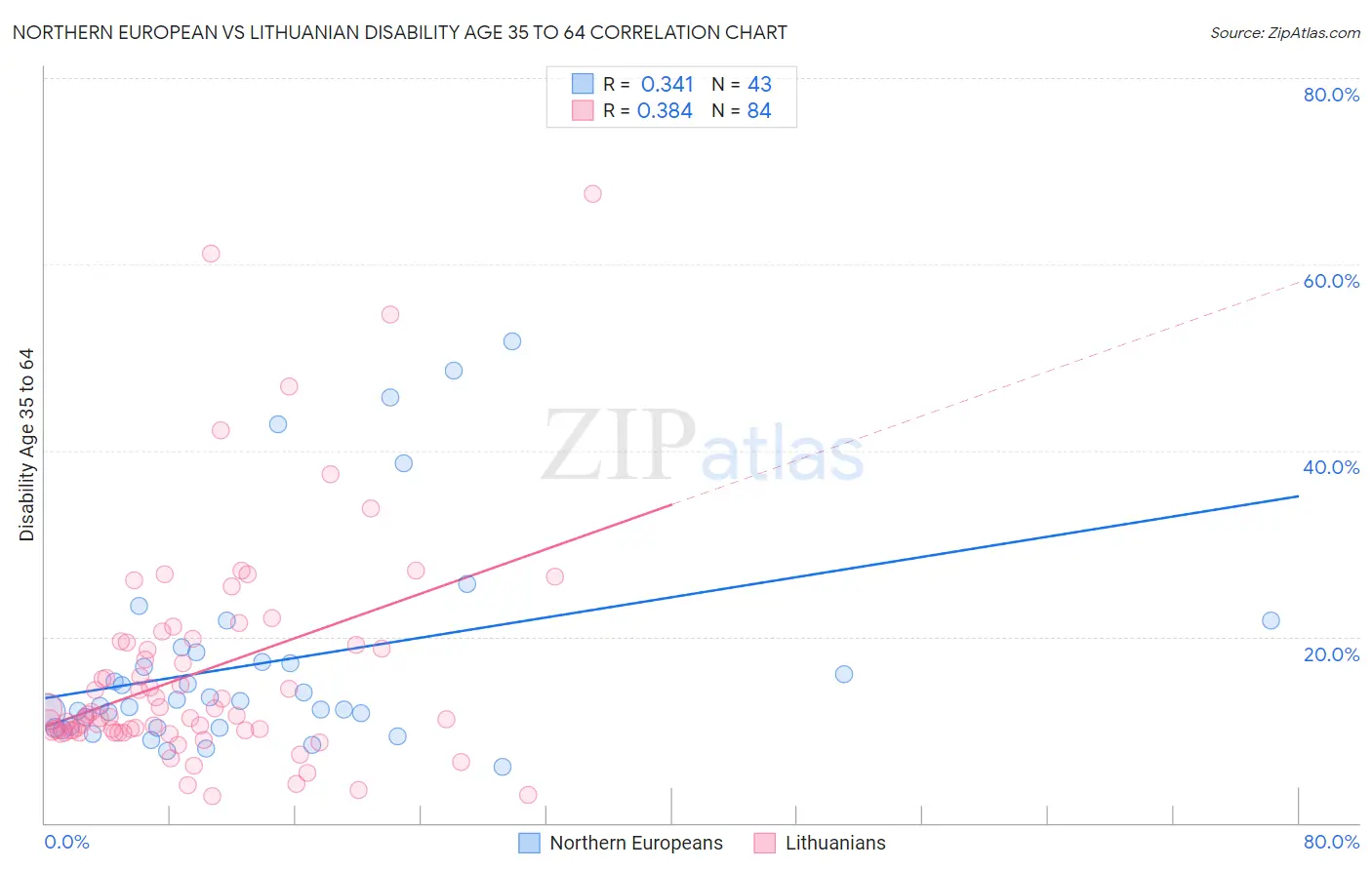Northern European vs Lithuanian Disability Age 35 to 64
COMPARE
Northern European
Lithuanian
Disability Age 35 to 64
Disability Age 35 to 64 Comparison
Northern Europeans
Lithuanians
11.4%
DISABILITY AGE 35 TO 64
34.9/ 100
METRIC RATING
188th/ 347
METRIC RANK
10.8%
DISABILITY AGE 35 TO 64
88.7/ 100
METRIC RATING
144th/ 347
METRIC RANK
Northern European vs Lithuanian Disability Age 35 to 64 Correlation Chart
The statistical analysis conducted on geographies consisting of 405,868,631 people shows a mild positive correlation between the proportion of Northern Europeans and percentage of population with a disability between the ages 34 and 64 in the United States with a correlation coefficient (R) of 0.341 and weighted average of 11.4%. Similarly, the statistical analysis conducted on geographies consisting of 421,646,297 people shows a mild positive correlation between the proportion of Lithuanians and percentage of population with a disability between the ages 34 and 64 in the United States with a correlation coefficient (R) of 0.384 and weighted average of 10.8%, a difference of 5.6%.

Disability Age 35 to 64 Correlation Summary
| Measurement | Northern European | Lithuanian |
| Minimum | 6.0% | 2.9% |
| Maximum | 51.8% | 67.6% |
| Range | 45.7% | 64.7% |
| Mean | 17.2% | 16.1% |
| Median | 13.1% | 11.5% |
| Interquartile 25% (IQ1) | 10.3% | 9.9% |
| Interquartile 75% (IQ3) | 18.3% | 19.2% |
| Interquartile Range (IQR) | 8.0% | 9.3% |
| Standard Deviation (Sample) | 11.3% | 12.0% |
| Standard Deviation (Population) | 11.2% | 12.0% |
Similar Demographics by Disability Age 35 to 64
Demographics Similar to Northern Europeans by Disability Age 35 to 64
In terms of disability age 35 to 64, the demographic groups most similar to Northern Europeans are Immigrants from Bosnia and Herzegovina (11.4%, a difference of 0.020%), Hungarian (11.4%, a difference of 0.020%), Slovene (11.4%, a difference of 0.15%), Danish (11.4%, a difference of 0.16%), and Immigrants from Nigeria (11.4%, a difference of 0.21%).
| Demographics | Rating | Rank | Disability Age 35 to 64 |
| Trinidadians and Tobagonians | 40.8 /100 | #181 | Average 11.4% |
| Icelanders | 39.7 /100 | #182 | Fair 11.4% |
| Immigrants | Oceania | 39.5 /100 | #183 | Fair 11.4% |
| Kenyans | 39.2 /100 | #184 | Fair 11.4% |
| Danes | 36.8 /100 | #185 | Fair 11.4% |
| Slovenes | 36.6 /100 | #186 | Fair 11.4% |
| Immigrants | Bosnia and Herzegovina | 35.2 /100 | #187 | Fair 11.4% |
| Northern Europeans | 34.9 /100 | #188 | Fair 11.4% |
| Hungarians | 34.6 /100 | #189 | Fair 11.4% |
| Immigrants | Nigeria | 32.5 /100 | #190 | Fair 11.4% |
| Swedes | 31.3 /100 | #191 | Fair 11.4% |
| Norwegians | 29.7 /100 | #192 | Fair 11.5% |
| Immigrants | Africa | 29.0 /100 | #193 | Fair 11.5% |
| Immigrants | Latin America | 27.5 /100 | #194 | Fair 11.5% |
| Carpatho Rusyns | 25.3 /100 | #195 | Fair 11.5% |
Demographics Similar to Lithuanians by Disability Age 35 to 64
In terms of disability age 35 to 64, the demographic groups most similar to Lithuanians are Sierra Leonean (10.8%, a difference of 0.21%), Immigrants from Saudi Arabia (10.8%, a difference of 0.43%), Australian (10.8%, a difference of 0.46%), Immigrants from Bangladesh (10.9%, a difference of 0.58%), and Immigrants from Scotland (10.7%, a difference of 0.59%).
| Demographics | Rating | Rank | Disability Age 35 to 64 |
| Immigrants | Costa Rica | 91.7 /100 | #137 | Exceptional 10.7% |
| Immigrants | Southern Europe | 91.5 /100 | #138 | Exceptional 10.7% |
| Costa Ricans | 91.4 /100 | #139 | Exceptional 10.7% |
| Immigrants | Scotland | 91.3 /100 | #140 | Exceptional 10.7% |
| Australians | 90.7 /100 | #141 | Exceptional 10.8% |
| Immigrants | Saudi Arabia | 90.6 /100 | #142 | Exceptional 10.8% |
| Sierra Leoneans | 89.7 /100 | #143 | Excellent 10.8% |
| Lithuanians | 88.7 /100 | #144 | Excellent 10.8% |
| Immigrants | Bangladesh | 85.6 /100 | #145 | Excellent 10.9% |
| South American Indians | 83.5 /100 | #146 | Excellent 10.9% |
| Immigrants | Eritrea | 83.4 /100 | #147 | Excellent 10.9% |
| Arabs | 82.7 /100 | #148 | Excellent 10.9% |
| Immigrants | Cameroon | 81.1 /100 | #149 | Excellent 10.9% |
| Syrians | 79.8 /100 | #150 | Good 11.0% |
| New Zealanders | 79.3 /100 | #151 | Good 11.0% |